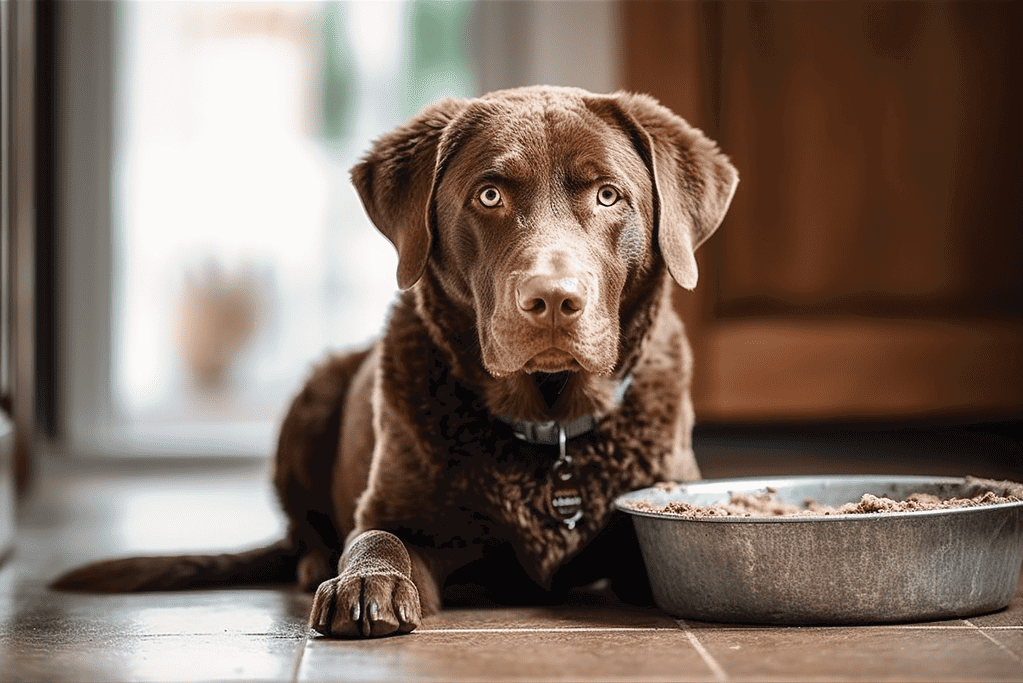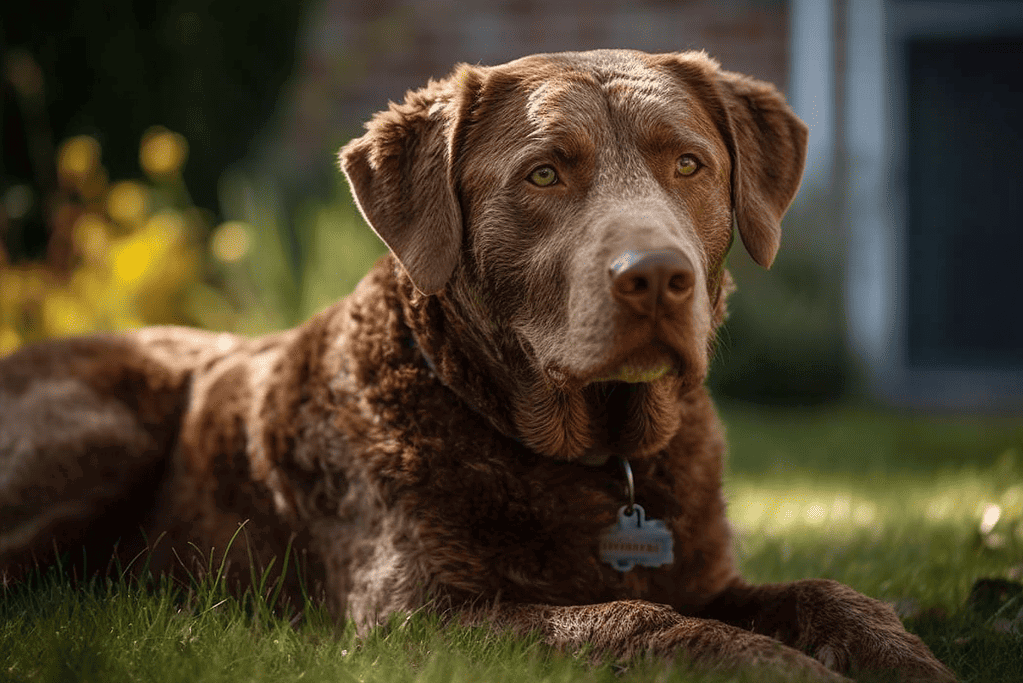
Chesapeake Bay Retriever Dogs: Facts, Photos, Care Tips, and More
Shortcuts
This versatile dog was specifically bred in Maryland during the early 1800s for its exceptional swimming abilities and resilience in the cold waters of the Chesapeake Bay. Whether for companionship, guarding, or other work, the Chesapeake Bay Retriever (Chessy) is a remarkable breed worth considering.
Breed Overview

Height
21-26 inches
Weight
55-80 pounds
Lifespan
10-13 years
Colors
Brown, Sedge, Deadgrass
Suitable for
Active families, hunters, and those looking for an intelligent, loyal companion
Temperament
Friendly, sociable, playful, intelligent, protective


Height
21-26 inches
Weight
55-80 pounds
Lifespan
10-13 years
Colors
Brown, Sedge, Deadgrass
Suitable for
Active families, hunters, and those looking for an intelligent, loyal companion
Temperament
Friendly, sociable, playful, intelligent, protective

Chesapeake Bay Retrievers, affectionately known as Chessies, are prized for their water-repellent coats, seemingly endless energy, and impressive swimming prowess. Their rugged nature makes them exceptional cold-water retrievers. However, some characteristics that contribute to their retrieving abilities may not be ideal for a family pet. Chessies can be somewhat territorial and display mild aggression. Additionally, their independent nature can make training a challenge, so it’s crucial to begin obedience training early on. Despite these traits, Chessies are incredibly loving towards their owners and are naturally cautious around strangers, making them excellent guard dogs or watchdogs. They are protective and can even be good with children. However, it is essential to understand that a Chessy thrives when given a meaningful job to do. At their core, they are retrievers, and keeping them mentally and physically engaged is vital for their overall well-being.
Characteristics
Energy

Health

Sociability

Trainability

Lifespan


Enjoying this read?
We publish this content for free to generate interest in our Premium members' area. By subscribing, you can ask the writer any questions related to pet care and this article, get access to 100+ Premium Pet Care Guides and go Ad-Free with DogFix Premium for $2.99.
Health Conditions
Fortunately, the Chessy is an exceptionally robust dog breed, with only a handful of conditions affecting them. Responsible breeders are diligent in avoiding the breeding of dogs exhibiting these issues, resulting in their infrequency.
Minor Conditions
- Allergies
- Ear Infections
- Eye Problems
- Hypothyroidism
- Obesity
Serious Conditions
- Hip Dysplasia
- Elbow Dysplasia
- Von Willebrand’s Disease
- Progressive Retinal Atrophy (PRA)
- Gastric Dilatation-Volvulus (Bloat)



Choosing Your Chesapeake Bay Retriever Puppy: What to Consider
Chesapeake Bay Retrievers are specifically bred for their exceptional ability to retrieve waterfowl. Consequently, breeders focus on enhancing traits that maintain the breed’s status as one of the top waterfowl retrievers globally, which often results in a higher price tag. It’s important to note that there’s a wide variety of quality and prices within this breed, with the best specimens possessing a reputable pedigree and showcasing the ideal physical and behavioral characteristics of exceptional retrievers. In many cases, adopting a Chesapeake Bay Retriever can be more cost-effective than buying a puppy from a breeder, and it may even offer additional benefits. For instance, the dog might already be spayed or neutered and have received its vaccinations, further reducing the medical expenses typically associated with acquiring a new puppy.

Understanding the Temperament and Intelligence of Chesapeake Bay Retrievers
Chesapeake Bay Retrievers are highly intelligent canines with an abundance of energy. They possess remarkable endurance, which can make them extremely lively if not provided with a physically demanding task. These dogs are known for their independence, which, while advantageous for a retriever, might not be the most desirable characteristic in a companion pet and can make training a challenge. Chessies are naturally territorial and can display mild aggression. However, consistent socialization and training from a young age can help manage these tendencies. Despite this, they are known to be affectionate and friendly towards their family members. Chesapeake Bay Retrievers tend to be cautious around strangers, and when combined with their alertness and innate protective instincts, they make excellent guard dogs and watchdogs.

Are Chesapeake Bay Retrievers Right for A Family?
Chesapeake Bay Retrievers can be a suitable choice for families, but it really depends on the particular family dynamics. These dogs aren’t known for being cuddly, doting lapdogs. Instead, they thrive on being active and engaged constantly. While they can demonstrate affection, they aren’t overly expressive in this regard. Families with multiple members may find it easier to accommodate the high exercise requirements of a Chessy. If the family enjoys hunting, then the Chesapeake Bay Retriever would be an ideal match. They have been known to interact well with children, although it’s not a hallmark of the breed. Their protective instincts make them excellent watchdogs for families, contributing to their potential suitability as family pets.

How Well Do Chesapeake Bay Retrievers Get Along with Other Pets?
Chesapeake Bay Retrievers may sometimes struggle with developing friendships with other pets. Male Chessies are known to display aggression towards fellow canines, while females can be quite territorial, particularly after having puppies. However, when raised alongside other dogs, Chessies can usually adapt and coexist peacefully as they mature. To ensure a harmonious relationship with other pets and even humans, it is crucial to provide early socialization and training for your Chesapeake Bay Retriever.

Nutritional Requirements for Your Chesapeake Bay Retriever
Your Chesapeake Bay Retriever’s food intake relies on various factors, such as their age, size, and activity level. Typically, these energetic dogs consume 2-2.5 cups of dry kibble daily. It’s essential to choose a high-quality, nutrient-rich diet to fuel their active lifestyle. Since this breed is prone to hip dysplasia, select food that contains ample glucosamine and chondroitin. You can also consider additional joint supplements to further support their joint health. If needed, feel free to add these compounds as supplemental additions to your dog’s diet, which can help minimize the risk of joint issues.

Exercise Needs for Your Chesapeake Bay Retriever
One of the most challenging aspects of owning a Chesapeake Bay Retriever is meeting their substantial exercise requirements. From a young age, these dogs need plenty of physical activity. Puppies as young as 9 weeks old require 20-30 minutes of daily exercise, including half-mile walks and energetic playtime for those up to 6 months old. It’s essential to avoid jogging with puppies, as it can harm their developing joints and bones. However, once your Chessy turns one year old, you can begin jogging together, starting with a mile and gradually increasing the distance as they become accustomed to regular runs.
A fully grown Chesapeake Bay Retriever needs at least an hour of exercise each day to stay happy and healthy. These dogs possess an abundance of energy, and without proper outlets, they may become bored, leading to issues such as depression, destructive behaviors, and other undesirable problems. Chessies thrive when given a physically demanding task to accomplish, like hunting and retrieving, which is what this breed was designed for. Ensuring your Chessy gets the exercise they need will help them live their best life as a loyal and loving companion.


Essential Grooming Tips for Chesapeake Bay Retrievers
The Chesapeake Bay Retriever boasts a unique waterproof double coat that feels somewhat oily to the touch. This coat requires regular attention, as the topcoat is thick and short, while the undercoat is dense and fine. It’s crucial to regularly brush your Chessy to avoid matting and to distribute the natural oils evenly. However, refrain from bathing them too frequently, as it can strip these essential oils from their coat and skin. A bath once or twice a year should suffice.


Comparing Male and Female Chesapeake Bay Retrievers
In general, the distinctions between male and female Chesapeake Bay Retrievers mirror those found in other breeds. Males typically have a larger build, with the heaviest individuals usually being male. While females tend to be more territorial by nature, males may exhibit slightly increased aggression. However, these differences often become less pronounced after spaying or neutering your pet.

Interesting Fact About Chesapeake Bay Retrievers
While state dogs are relatively uncommon in the US, with only 13 states having an official canine representative, Maryland was the first to designate one—the Chesapeake Bay Retriever.

Fascinating Fact 2 About Chesapeake Bay Retrievers
The fascinating origin of the Chesapeake Bay Retriever can be traced back to a shipwreck and two resilient dogs, Sailor and Canton. After swimming to the Maryland shoreline, these dogs’ exceptional retrieving skills caught the attention of local residents. They decided to breed Sailor and Canton with native dogs, resulting in the creation of a unique breed now known as the Chesapeake Bay Retriever, in honor of the place where their story began.


Concluding Thoughts on the Chesapeake Bay Retriever Breed
Chesapeake Bay Retrievers make fantastic dogs, and can even thrive as pets, although their true calling lies in their exceptional ability as cold-water retrievers. These dogs possess a certain level of independence that can make training a bit challenging, but it’s this very independence that allows them to excel as retrievers. Additionally, their natural protectiveness, alertness, and wariness of strangers make them excellent guard dogs and watchdogs.


Didn’t find what you need? Use the search!
Search our database of over hundreds of posts with up-to-date information from our experts and veterinarians.

